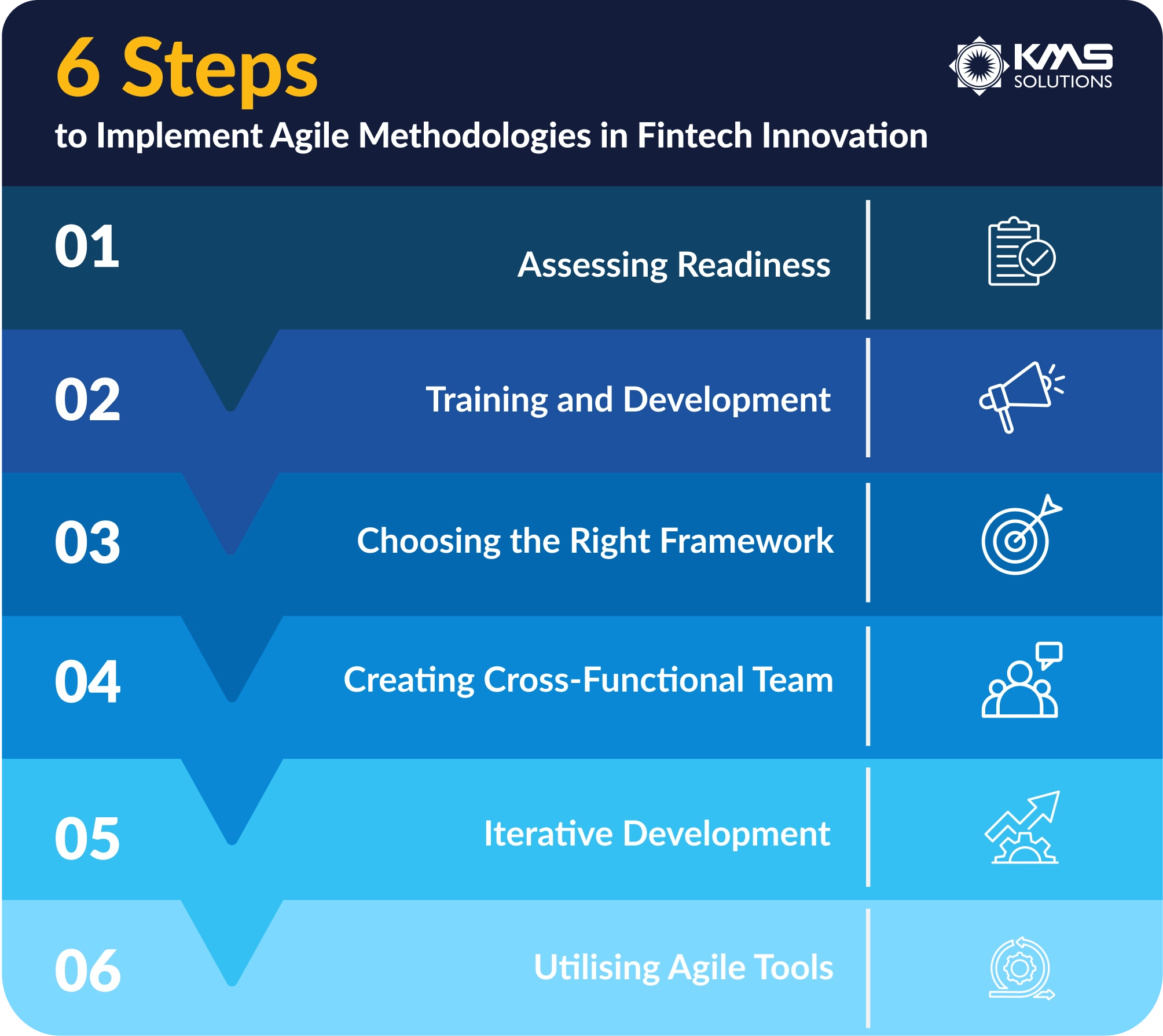For organisations looking to break ahead with their financial services, staying ahead of the competition means being agile, innovative, and customer-focused.
Agile software development has become a game-changer for Fintech companies, offering a flexible and efficient way to create cutting-edge financial technology solutions. In this article, our experts at KMS Solutions delve into how agile methodologies can transform financial services, providing practical insights for Fintech innovation in Australia.
What are Agile Practices in Software Development?
Agile practices within software development are a dynamic and iterative approach to software creation that emphasises flexibility, collaboration, and customer satisfaction.
Unlike traditional waterfall models, agile methodologies break down projects into smaller, manageable increments called sprints. Each sprint delivers a functional piece of the software, allowing for continuous feedback and improvements.
Key agile methodologies include:
- Scrum: this is one of the most widely adopted agile methodologies, characterized by its iterative and incremental approach. Scrum teams often work in short iterations called sprints that typically last 2-4 weeks. Each sprint begins with a planning meeting where the team selects items from the product backlog to work on, and at the end of each sprint, they conduct a sprint review and retrospective to reflect on progress and plan for the next iteration.
- Kanban: is a visual management method that emphasizes workflow optimization and continuous delivery. Teams using Kanban visualize their work on a Kanban board, which consists of different stages of the development process (e.g., to do, in progress, done). Kanban promotes limiting work in progress (WIP) to improve flow and reduce bottlenecks, enabling teams to deliver value more predictably.
- Lean: Lean software development applies lean principles borrowed from manufacturing to software development. It emphasizes maximizing customer value while minimizing waste through practices like value stream mapping, just-in-time delivery, and continuous improvement. This approach encourages iterative development, rapid feedback, and reduced cycle times to deliver software efficiently and effectively.
According to a report by the Project Management Institute, 71% of organisations reported using agile approaches for their projects, highlighting its widespread adoption.
Benefits of Agile Software Development in Financial Services
Flexibility and Adaptability
Agile allows financial services companies to quickly adapt to changing market conditions and customer demands. By breaking projects into smaller parts, teams can pivot and make necessary adjustments without derailing the entire project. Integrating such flexibility into your operations is particularly pivotal in the financial sector, where regulatory changes and market dynamics can shift rapidly.
Improved Collaboration
Agile methodologies foster enhanced teamwork and communication. Daily stand-up meetings, sprint reviews, and retrospectives ensure that all team members align with common goals and that any issues are addressed promptly. Working in a collaborative environment leads to better problem-solving and more innovative solutions, which are essential for driving Fintech innovation.
Faster Time-to-Market
With shorter development cycles and continuous delivery, agile practices enable financial services firms to bring new products to market faster. Working with greater speed is what gives you a competitive edge in the saturated Fintech landscape, where being first to market can provide a significant advantage. Companies can quickly roll out new features and improvements by delivering functional software at the end of each sprint.
Risk Management
When developing financial services software, BFSI businesses often have to face different kinds of risks, including market risk, operational risk, and compliance risk. Agile’s iterative nature allows for continuous testing and feedback, helping to identify and mitigate risks early in the development process. The proactive approach reduces the likelihood of major issues later on, ensuring that financial software remains secure and reliable. Regular reviews and adjustments based on feedback also mean that the final product is more likely to meet user needs.
Customer-Centric Approach
Agile methodologies involve customers throughout the development process, ensuring that the final product meets their needs and expectations. Regular feedback loops and user testing are essential to this approach, leading to higher customer satisfaction and better product-market fit. In the financial services industry, where customer trust is paramount, this focus on user needs is particularly valuable.
Implementing Agile Methodologies in Fintech Innovation

Step 1: Assessing Readiness
Evaluate your organisation’s readiness for agile transformation, such as understanding and outlining your current processes, identifying potential barriers, and securing executive support. Conducting an initial assessment can help determine whether your company is prepared for the cultural shift that agile requires.
Step 2: Training and Development
Provide agile training and resources for your teams. Invest in workshops, certifications, and ongoing learning opportunities to build a strong foundation in agile practices. Ensuring that all team members understand agile principles and practices is critical to successful implementation.
Step 3: Choosing the Right Framework
Select an agile methodology that fits your Fintech project needs. Whether it’s Scrum, Kanban, or Lean, choose a framework that aligns with your team’s strengths and project goals. Each framework has unique advantages, so choosing one that best suits your specific requirements is important.
Step 4: Creating Cross-Functional Teams
Build teams with diverse skills and expertise. Agile cross-functional teams enhance collaboration and ensure that all aspects of the project are covered. Involving members from different departments, such as development, testing, and operations, can lead to more holistic and effective solutions.
Step 5: Iterative Development
Focus on incremental financial services software development and continuous improvement. Break down projects into smaller sprints, deliver functional pieces, and iterate based on feedback. Operating with this approach allows for ongoing refinement and ensures that the final product evolves to effectively meet user needs.
Step 6: Utilising Agile Tools
Leverage tools like JIRA, Trello, and Asana to manage agile projects. These tools help visualise workflows, track progress, and facilitate communication among team members. Using the right tools can streamline project management and make it easier to implement agile practices effectively.
Overcoming Challenges in Adopting Agile Software Development
Resistance to Change
Managing and mitigating resistance within the organisation will help the adoption of agile practices in software development. Clearly communicate the benefits of agile to your team, involve key stakeholders in your financial services planning processes, and provide continuous support to ease the transition. Creating a change management plan can help address concerns and ensure a smoother adoption process.
Scaling Agile
Scaling agile methodologies across large teams and projects can be challenging. Implement frameworks like SAFe (Scaled Agile Framework) or LeSS (Large Scale Scrum) to ensure consistency and alignment, as they provide structured approaches to scaling agile practices.
Faster Time-to-Market
Ensure high-quality outputs through continuous testing and review. Incorporate automated testing and regular code reviews to maintain standards. Establishing a strong quality assurance process ensures that the final product meets all requirements and performs reliably.
Regulatory Compliance
Balancing agile practices with regulatory requirements in the financial sector is essential. Develop processes that incorporate compliance checks without disrupting agile workflows. Working closely with compliance teams can help integrate regulatory requirements seamlessly into the development process.
Explore Agile Methodologies in Developing Financial Software with KMS Solutions
Agile practices in software development offer numerous benefits for financial services companies, from increased flexibility and faster time-to-market to improved collaboration and risk management.
By embracing agile methodologies, Fintech companies in Australia can drive innovation and stay competitive in a rapidly changing industry. If you would like to learn more and start your agile transformation journey today, speak with our experts at KMS Solutions today.










